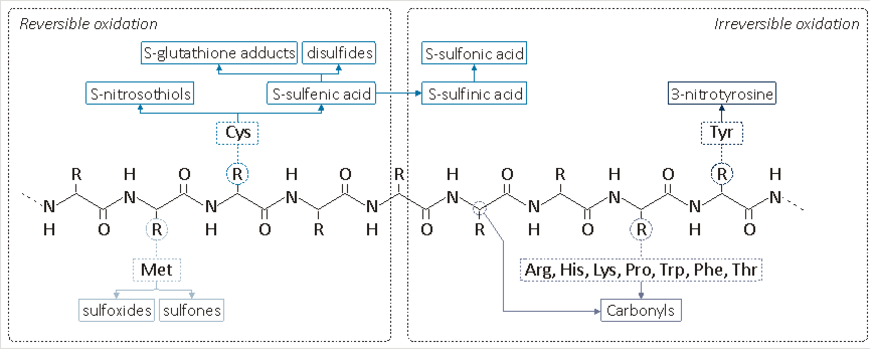Research focus
Aging, diet and oxidation processes
Aging is a complex, physiological process that contributes to the loss of cell stability, integrity, and function and that finally results in the death of the organism. The underlying mechanisms of the aging process are complex and characterized by the interaction of different processes. Thereby, particularly oxidation processes contribute to the aging process per se and to the manifestation of typical aging phenomena such as reduction of renal and lung function as well as a generally reduced resistance and the development of age-related diseases. The entirety of individual aging phenomena is also referred to as the aging phenotype.
The dynamics of the aging process are highly variable among individuals and the life expectancy and number of so-called healthy years of life (years without illnesses or "health span") differ significantly. In this context, several genetic components associated with increased life expectancy and health span have been identified, but their overall significance is rather low. On the other hand, environmental factors (such as toxin and radiation exposure) and lifestyle have a significantly greater impact on the individual's aging phenotype, with nutrition being identified as a particularly significant component.
The effects of different dietary habits on the aging process and aging phenotype are complex. On the one hand, chronic hyperalimentation with excessive energy intake contributes to the increased formation of reactive oxygen species (ROS), which in turn favors oxidation processes, leading to the development of age-related diseases such as cardiovascular disease and diabetes mellitus type 2. On the other hand, the diet also provides antioxidative micronutrients mainly in the form of vitamins (vitamin E, vitamin C) and phytochemicals (e.g., phenols such as resveratrol in red wine, alliin in garlic), which provide beneficial effects on the general oxidative status.
Through oxidation processes most macromolecules of the organism are modified in their structure and function. In this context, however, in particular the oxidation of endogenous proteins seems to act as a physiological sensor and mediator and to allow the adaptation of the metabolism to a changed internal environment and changed environmental conditions.
Oxidative posttranslational protein modifications
Oxidative posttranslational protein modifications (oxPTM) influence the protein structure and thus different protein properties such as e.g. the activity of enzymes and transporters, the affinity for binding partners as well as the stability and localization of proteins. Thus, oxPTM are involved in the regulation of various signaling pathways and cellular processes such as energy metabolism, immune function, apoptosis (programmed cell death), and vascular function.
The expression of oxPTM is multifarious and numerous different oxPTM species are known, which are divided into reversible and irreversible oxPTM and differ in their importance for the metabolism (Figure). Particularly susceptible to oxidation processes are the side chains of the thiol-containing amino acids cysteine and methionine as well as basic and aromatic amino acids. Since the formation of oxPTM is mainly dependent on the availability of ROS and RNS as well as the amino acid sequence and the local microenvironment and is catalyzed only indirectly by enzymes, it allows the ad hoc regulation of the metabolism. In this context, particularly reversible oxPTM of cysteine are involved in the dynamic modulation of metabolic processes, and thus are of major interest of the Junior Research Group ProAID.
However, the increased formation of ROS and RNS (e.g. due to an increased substrate flux in the cellular metabolism, inadequate concentration and activity of antioxidant enzymes, and availability of antioxidants) may lead to the uncontrolled formation of oxPTM and contribute to the pathogenesis and pathophysiology of chronic degenerative diseases (e.g. insulin resistance, diabetes mellitus type 2, cardiovascular disease) as well as to the individual aging process and expression of the aging phenotype. Since nutrition supplies metabolizable substrates as well as antioxidants it is of particular importance for the maintenance of the body's redox homeostasis (balance in formation and degradation of ROS and RNS) and represents a relevant regulatory mechanism for the formation of oxPTM. OxPTM are thus endogenous targets for the manipulation of the metabolism and the aging process, that additionally reveal an extraordinary potential as biomarker for the individual's metabolic status as well as the development of individualized strategies for diagnosis, prevention and therapy of age- and diet-related diseases.
The importance of oxPTM for the development and expression of age- and diet-related diseases is studied in vivo and in vitro in different project in targeted as well as untargeted approaches using among other things mass spectrometry based methods, immunoassays as well as activity assays.

